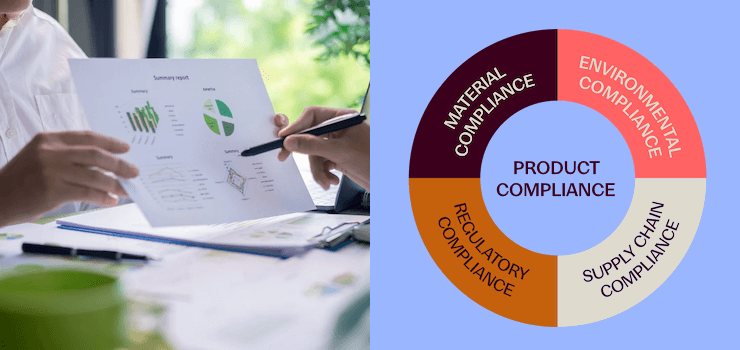Understanding Scope 3 emissions is no longer optional – it’s a regulatory imperative. Under the Corporate Sustainability Reporting Directive (CSRD), companies must account for indirect emissions across the entire value chain. That means not just internal operations, but also upstream and downstream impacts. Scope 3 is complex, data-intensive, and essential for credible sustainability performance.
This article unpacks what CSRD really means for Scope 3 – and how companies can turn compliance pressure into strategic advantage.
Table of Contents
- CSRD at a Glance: Linking Scope 1, 2 and 3
- What Scope 3 Really Covers: Beyond Company Borders
- CSRD Requirements for Scope 3: Turning Expectation into Obligation
- Why Scope 3 Is So Challenging: Data Gaps and Supply Chain Blind Spots
- How to Get Ready: Building a Scalable Scope 3 Strategy
- IPOINT’s Solution: Turning Scope 3 Complexity into Actionable Insights
CSRD at a Glance: Linking Scope 1, 2 and 3
The Corporate Sustainability Reporting Directive (CSRD) significantly raises the bar for sustainability disclosures in the EU. It replaces and expands the previous Non-Financial Reporting Directive (NFRD), shifting from high-level narrative reports to detailed, standardized metrics across environmental, social, and governance topics.
At its core, the CSRD requires companies to report climate-related impacts across Scope 1, 2 and 3 emissions – including indirect value chain emissions (Scope 3). This marks a move from voluntary carbon tracking to mandatory, audit-ready reporting. The directive is based on the European Sustainability Reporting Standards (ESRS), which provide a unified framework for structuring and validating disclosures across industries.
Which Companies Must Comply with the CSRD?
As of the Simplification Omnibus Proposal published by the European Commission in February 2025, companies fall under the CSRD if they meet at least two of the following three threshold criteria:
- More than 1,000 employees
- A balance sheet total exceeding €25 million
- A net turnover over €50 million
This adjustment notably raises the bar for reporting obligations, particularly impacting medium-sized enterprises and EU subsidiaries.
New Timeline and Phased Implementation
While the CSRD remains active EU law, the Omnibus Proposal has postponed and phased some reporting obligations to reduce administrative burden and allow for better preparation. The revised timeline now looks as follows:
- FY 2025: Listed large companies already subject to the NFRD begin reporting (reports due in 2026).
- FY 2026–2027: Other large companies follow, depending on eligibility and structure.
- FY 2028: Most remaining in-scope companies must comply.
Sector-specific standards have been deferred, and simplified reporting is introduced for certain cross-border or non-EU entities. However, Scope 3 reporting remains mandatory for all companies where these emissions are material – regardless of sector or location.
What Scope 3 Really Covers: Beyond Company Borders
.png?width=4339&height=2633&name=ccf_scopes-new(1).png)
Scope 3 refers to all indirect greenhouse gas (GHG) emissions that occur outside a company’s direct control – but within its value chain. The Greenhouse Gas Protocol, which underpins the CSRD’s reporting logic, defines 15 Scope 3 categories across upstream and downstream activities.
| Upstream examples | Downstream examples |
| Purchased goods and services | Product use and energy consumption |
| Capital goods and inbound logistics | Distribution and franchises |
| Business travel and waste from operations | End-of-life treatment and disposal |
Scope 3 often includes the largest emission sources – especially in sectors like manufacturing, automotive or consumer goods. While Scope 1 and 2 emissions are easier to quantify, CSRD Scope 3 reporting requires data from suppliers, customers, and recyclers. That makes Scope 3 both the most material and most difficult element of the corporate CSRD carbon footprint.
A clear understanding of these categories is essential – not only for compliance, but also for identifying emission hotspots, supply chain risks, and reduction opportunities.
Fast-track Your Carbon Footprint Today
Automate data collection, improve data quality, and deliver audit-ready CSRD reports with one integrated platform for corporate and product carbon accounting.
CSRD Requirements for Scope 3: Turning Expectation into Obligation
Under the CSRD, Scope 3 reporting shifts from voluntary best practice to binding requirement. Companies must disclose all relevant value-chain emissions, using the Greenhouse Gas Protocol as the methodological foundation and aligning with the CSRD’s ESRS framework – especially ESRS E1 Climate Change.
Core requirements include:
- Complete quantification of all material Scope 3 categories
- Justification for exclusions, backed by transparent reasoning
- Emission reduction targets that include Scope 1, 2 and 3
- Data quality assessments and updates on improvement actions
- Supplier engagement strategies to close information gaps
These disclosures must be audit-ready and structured according to double materiality principles – showing not just how climate affects the company, but how the company contributes to climate change.
Why Indirect Emissions Are So Challenging: Data Gaps and Supply Chain Blind Spots
When it comes to CSRD Scope 3 compliance, technical calculation methods are only part of the equation. The real challenge lies in operationalizing them across fragmented, global value chains.
Key friction points include:
- Data availability: Many suppliers lack digital systems or are reluctant to share emission data.
- Data quality: Estimates and industry averages still dominate, undermining audit readiness.
- Complexity: Multi-tier supply chains with thousands of inputs make tracing emissions a logistical burden.
- Control: Companies often have little leverage over downstream actors or product use phases.
Even large corporations struggle to gather consistent upstream figures, especially when working with SMEs or non-EU suppliers. And once collected, validating and consolidating that data into a single, CSRD-compliant Scope 3 footprint is a major operational task.
Regulators expect transparency over data limitations – but not excuses. Companies must show how they deal with gaps, engage partners, and improve year over year.
How to Get Ready: Building a Scalable Scope 3 Strategy
Preparation for CSRD-aligned Scope 3 reporting should begin with a structured readiness roadmap. Piecemeal efforts won’t scale – companies need systems that can grow with regulatory demands.
Steps to move from theory to action:
- Run a Scope 3 screening: Map out all 15 categories, identify hotspots, and define what’s material.
- Prioritize supplier engagement: Start with strategic suppliers in high-impact categories.
- Choose the right tools: Use digital platforms that support emission calculation, data validation, and workflow integration.
- Document methodologies: Ensure traceability of assumptions, data sources, and boundary decisions.
- Track progress: Build in review cycles to assess improvements in data quality and coverage.
Smart companies combine digital infrastructure with governance – assigning internal roles, setting milestones, and investing in training. That’s how compliance becomes not just a duty, but a driver of operational resilience and transparency.
IPOINT’s Solution: Turning Scope 3 Complexity into Actionable Insights

Managing CSRD Scope 3 emissions requires more than just data collection – it demands a comprehensive approach that integrates carbon accounting, life cycle assessment, and supply chain transparency. IPOINT offers a suite of solutions designed to address these challenges:
Carbon Footprint
IPOINT's Carbon Footprint Software enables companies to calculate both Product Carbon Footprints (PCF) and Corporate Carbon Footprints (CCF) in accordance with international standards such as ISO 14064, ISO 14067, PAS 2050, and the GHG Protocol. This tool helps identify emission hotspots and supports the development of effective reduction strategies.
Life Cycle Assessment (LCA)
With IPOINT's LCA software, businesses can perform comprehensive analyses of environmental impacts throughout a product's life cycle. This approach ensures that sustainability efforts are not just focused on direct emissions but encompass the entire value chain.
Supply Chain Transparency
IPOINT's solutions enhance supply chain transparency by facilitating the collection and analysis of data from suppliers. This capability is crucial for understanding and managing Scope 3 emissions, as it provides insights into upstream and downstream activities.
Frequently Asked Questions
Is Scope 3 reporting mandatory under CSRD?
Yes – if your company meets the CSRD thresholds, you must report Scope 1, 2 and 3 emissions. Under ESRS E1, Scope 3 is treated as a core part of your climate disclosures and must be included unless clearly justified otherwise.
Why is Scope 3 reporting relevant for investors and ESG ratings?
Scope 3 emissions are increasingly scrutinized by investors, ESG rating agencies, and financial institutions. Under frameworks like the EU Taxonomy and SFDR, companies must show how they manage climate-related risks across the entire value chain – including upstream and downstream emissions.
High-quality Scope 3 disclosures can positively influence ESG scores, build stakeholder trust, and support access to sustainable finance. Conversely, insufficient reporting may raise red flags, limit green funding opportunities, or result in negative assessments by analysts and regulators.
When do companies need to start reporting Scope 3 emissions?
Large public-interest entities report for fiscal year 2025 (published in 2026), with smaller in-scope companies following in phased waves. The 2024 Omnibus proposal may shift certain deadlines, but it does not remove the Scope 3 requirement.
What makes Scope 3 emissions so difficult to measure?
Data quality suffers from supply-chain complexity – thousands of suppliers, limited primary data and varying calculation methods. Reliance on averages and estimates increases uncertainty and raises the bar for verification.
How can software help with Scope 3 compliance?
Automated carbon-footprint and supply-chain-transparency tools streamline supplier data collection, apply GHG-Protocol methods, and generate audit-ready reports. Explore IPOINT’s Carbon Footprint Software and Supply Chain Transparency solutions for a scalable path to compliance.






.png)
